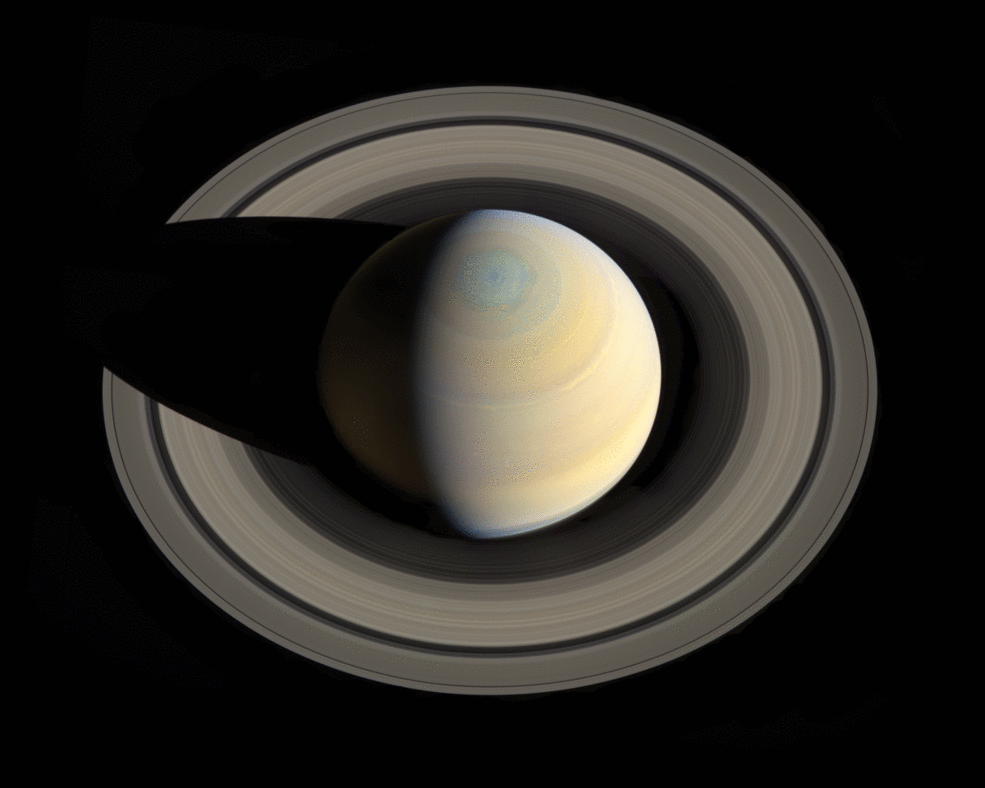It’s a good time to see Saturn in terms of closeness to Earth and height in the sky, but if you take a look through a small telescope you might get a shock. The rings will be barely visible. Although they will gradually return to view, it’s likely that what you are seeing is a forewarning of a future in which the Solar System will be without one of its most cherished sights. So why the short- and long-term disappearances?
The reasons the rings are temporarily invisible, and why they are expected to vanish over a much longer timeframe are different, but there is a connection.
The key fact is that the rings are immensely thin. From one tip to another the rings span 560,000 kilometers (175,000 miles), and even leaving out the faint E ring are spread over an area many times larger than the surface of the Earth. On the other hand, they are mostly just 10 meters (33 feet) thick. Consequently, when seen from edge-on, they are effectively invisible, at least from a distance.
As Saturn’s seasons change, its equator moves relative to the Sun, just as ours does. In Saturn’s case, the rings swing with it, and become edge-on to us every 13-15 years. This happened in March, although with the Sun in between us it was not easy to see. Six months later, the rings are still close enough to edge-on that they look more like a dark line across the planet than their usual beautiful gold. The Earth passed Saturn on its way around the Sun on September 21, so now is the ideal time to catch this view.
The cycle of Saturn’s seasons will continue, and with them every Saturnian equinox the rings will turn edge-on again, but over time there may be less ring to see at other times. Here the thinness makes them vulnerable to loss.

When we measure the rings, we usually leave out the giant, but very faint, E ring.
Image credit: NASA/JPL
The origin of the rings remains debated, but most planetary scientists favor the view that they formed at most 400 million years ago, making them less than a 10th the age of the planet. This estimate is based on the dust that covers the ice fragments that form the rings, but some other approaches have produced even shorter lifespans.
If the rings didn’t exist 500 million years ago, it’s natural to ask if they’re now a permanent feature, or if we just got lucky in being around to see them.
No one knows the answer for sure, since we still don’t know why the rings exist in the first place. There are competing theories of this, but it’s considered likely that they are the result of a catastrophic event, such as two moons smashing into each other or one getting too close to Saturn and being pulled apart by its gravity.
Meanwhile, the rings are slowly shrinking, with a rain of fragments onto Saturn gradually diminishing their volume. Cassini measured ice from the inner ring falling on the equator, probably as a result of frictional forces causing a loss of orbital energy.
More recently it was discovered that Saturn’s magnetic field also interferes with the rings, causing ice that becomes electrically charged by UV light or micrometeorite bombardment to rain down on the poles, producing glowing bands in the process. “We estimate that this ‘ring rain’ drains an amount of water products that could fill an Olympic-sized swimming pool from Saturn’s rings in half an hour,” James O’Donoghue of NASA’s Goddard Space Flight Center said in a statement.
The E ring ring is being replenished by ice and silica particles from Enceladus’s geysers, but this process is nowhere near fast enough to compensate for the rate of loss.
Quite how long the rings have got is uncertain, but estimates range between 100 and 300 million years, unless some unknown source is supplementing them, or starts to do so soon.
The rings will not disappear all at once. As this illustration of their anticipated future shows, the inner B, C and D rings will disappear first, followed by a slow decline for the A and F rings.

Simulation of what will happen to Saturn’s rings unless something replenishes them, given the current rate of loss.
Image credit: NASA/Cassini/James O’Donoghue
Even after that, the rings may not be gone entirely. All three other giant planets in the Solar System have rings, so it seems like they are a feature of this type of planet. However, if the puny rings of Jupiter – which we only discovered by sending a space probe past – or Neptune are a forerunner of what will be left for our 10 million times over grandchildren, they might feel rather cheated. Maybe they’ll smash up a moon to return the rings to their glory.
Source Link: We’re Starting To See Saturn’s Rings Again – You Might Only Have 100 Million Years To Enjoy Them